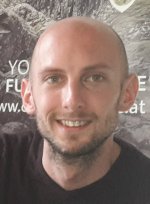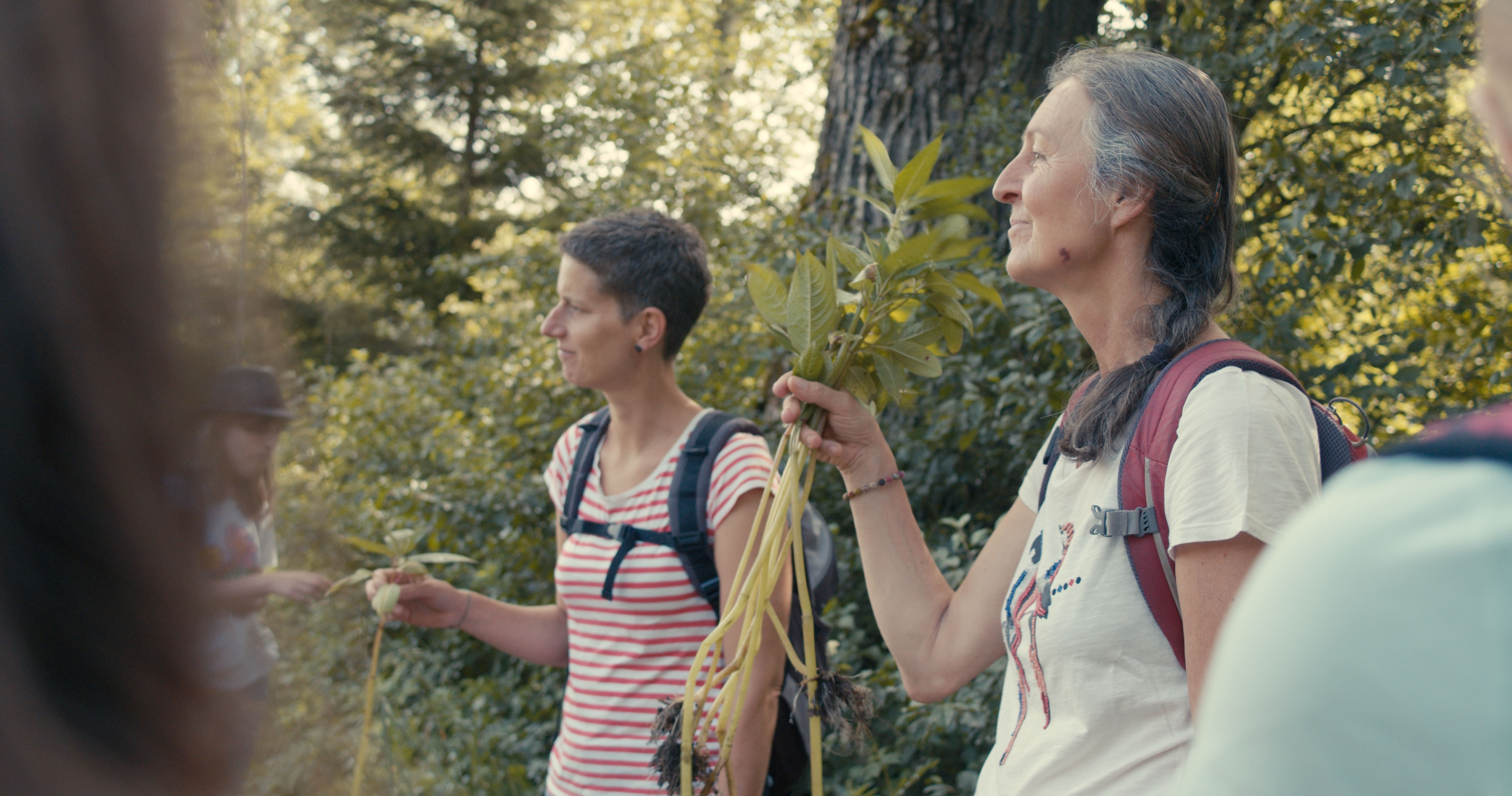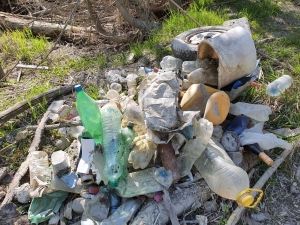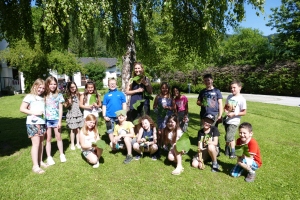
Florian Heigl
New Podcast Episode: What's flying here?
There is finally a new episode of our podcast Wissen macht Leute (Knowledge Makes People) - this time we present the project "Butterflies of Austria".
Video of the talk Citizen Science in Asia
You can now watch the video of Scott Edmunds' talk on Citizen Science in Asia on our YouTube channel.
Plastic Pirates
Plastic Pirates - Go Europe! A Citizen Science Initiative to investigate plastic pollution along rivers
The pollution of beaches and riverbanks in Europe with plastic waste does not stop at borders. Preventing micro- and macroplastics in the environment, addressing this challenge scientifically and researching sustainable materials are therefore tasks we need to work on together across Europe.
Plastic Pirates - Go Europe! was first developed in Germany in 2016. Since January 2022, with the support of the EU Commission, the initiative has been extended to the whole of Europe as a European citizen science action in which school classes and youth groups (young people aged 10-16) collect plastic samples from streams and rivers and document their findings. The data collected across Europe is entered into a database and then analysed by scientists. Young people who are interested in science and the environment are given the opportunity to participate in practical research. They make an important contribution to researching the state of European rivers and the extent and pollution caused by plastic waste.
As part of the project, the types of waste identified by the individual groups (e.g. cigarette butts, pieces of foil or packaging) are recorded on a suitable river bank or stream with the help of detailed action materials. The digital map shows where waste has already been collected. The data collected by the young people across Europe will be consolidated (zenodo) and will then help scientists to gradually close existing research gaps on the occurrence, composition and generation of plastic waste. Exciting results from Austria can be found on the results page of the Austrian Plastic Pirates (in German). Interested school classes and youth groups are cordially invited to participate in the initiative. All information about the "Plastic Pirates" can be found on our homepage (www.plastic-pirates.eu/at) or can be obtained by sending an email request to This email address is being protected from spambots. You need JavaScript enabled to view it..
Podcast episode
In November 2024, team members Gudrun Obersteiner, Anna Noichl and Anna-Sophia Schlagmann gave insights into the project on the Österreich forscht podcast Wissen macht Leute - you can listen to the episode here (in German).
Photo Gallery
-
 Citizen Scientists on their way to the collection Citizen Scientists on their way to the collection
Citizen Scientists on their way to the collection Citizen Scientists on their way to the collection -
 Group discussion of the collection protocols Group discussion of the collection protocols
Group discussion of the collection protocols Group discussion of the collection protocols -
 Collection at the Danube in Vienna Collection at the Danube in Vienna
Collection at the Danube in Vienna Collection at the Danube in Vienna -
 Throwing of the Manta net Throwing of the Manta net
Throwing of the Manta net Throwing of the Manta net -
 group C at the microplastics sampling group C at the microplastics sampling
group C at the microplastics sampling group C at the microplastics sampling -
 Manta net stabilised with PET bottles Manta net stabilised with PET bottles
Manta net stabilised with PET bottles Manta net stabilised with PET bottles -
 microplastic sampling with minister of education Polaschek microplastic sampling with minister of education Polaschek
microplastic sampling with minister of education Polaschek microplastic sampling with minister of education Polaschek -
 Minister Polaschek collects garbage for group B with Viennese students Minister Polaschek collects garbage for group B with Viennese students
Minister Polaschek collects garbage for group B with Viennese students Minister Polaschek collects garbage for group B with Viennese students -
 group B sorts their garbage finds group B sorts their garbage finds
group B sorts their garbage finds group B sorts their garbage finds -
 Garbage gets sorted Garbage gets sorted
Garbage gets sorted Garbage gets sorted -
 group B counts and documents their finds group B counts and documents their finds
group B counts and documents their finds group B counts and documents their finds -
 Picture for the data validation of the results of group B Picture for the data validation of the results of group B
Picture for the data validation of the results of group B Picture for the data validation of the results of group B -
 group A documents a photo of their transects for the data validation group A documents a photo of their transects for the data validation
group A documents a photo of their transects for the data validation group A documents a photo of their transects for the data validation -
 after uploading the data onto the website, they can be seen on the interactive map after uploading the data onto the website, they can be seen on the interactive map
after uploading the data onto the website, they can be seen on the interactive map after uploading the data onto the website, they can be seen on the interactive map -
 Plastic Pirates at the European Researchers' Night Plastic Pirates at the European Researchers' Night
Plastic Pirates at the European Researchers' Night Plastic Pirates at the European Researchers' Night -
 Microplastics Danube wetlands Microplastics Danube wetlands
Microplastics Danube wetlands Microplastics Danube wetlands -
 Plastic Litter National Park Donauauen Plastic Litter National Park Donauauen
Plastic Litter National Park Donauauen Plastic Litter National Park Donauauen
https://www.citizen-science.at/en/component/k2/author/934-florianheigl?start=80#sigProIdd25b3cd37c
This project fulfils version 1.1 of the quality criteria for citizen science projects on Österreich forscht.
Cowlearning
How can beef and milk consumption be made more sustainable? This is the question that the new citizen science project COwLEARNING at the University of Natural Resources and Life Sciences Vienna is exploring, and it relies on the strong participation of a wide range of stakeholders. From farmers to consumers: https://www.citizen-science.at/en/projects/cowlearning-875
C.S.I. PhänoBiota
Research with new plant aarivals from all over the world
DURATION: 01.05.2020 - 30.04.2023
In a first-of-its-kind approach in Europe, pupils in the district of Liezen are researching and documenting the phenological development of invasive neophytes under the influence of climate change. With the help of experts, they develop and test modern, multilingual field research instruments and educational tools, thus laying the foundation for a long-term, nationwide Citizen Science network. The observations are used to make neophyte management in the region more efficient, supported by phenological information. The project results thus not only have educational value, but also tangible ecological benefits.
What is happening in the project or has already happened?
In C.S.I. PhenoBiota, kindergarten children and pupils from all school levels in the Liezen district explore the exciting phenological world of neophytes together and at eye level with scientists. Equipped with comprehensive, age-appropriate research tools, they observe and document the phenological phases of selected plant species throughout the year, relate them to the climate and learn to draw professional conclusions. What is phenology? A large part of the material in C.S.I. PhenoBiota is developed together with the pupils. For example, a NawiTech research box for kindergarten children is being developed to make the project's main topics accessible to our youngest participants in a playful way and with all their senses. In the Girls only! programming course, schoolgirls develop a simple app.
.jpg)
Pupils observe with the Nature Calendar App © Marco Schupfer
With the help of the already existing nature calendar app and the new neophyte feature, parents, grandparents, siblings and other interested Citizen Scientists should also be encouraged to participate in the project and share their phenological observations. How does the app work (in German)? However, there is also an analogue way to record the phenological phases using observation sheets. Click here to download the sheets (in German). At the end of the project, the collected data will be used to create phenomenal hubs for all participating school classes, with the help of which our young researchers can forecast the annual development of neophytes in their region.
In addition, the pupils have the opportunity to work out and examine their own scientific questions that are of burning interest to them on the topic.
In the project, the young researchers accompany the entire process from the planning, development and implementation of phenological data collection to data evaluation and application of the findings. They also actively help to communicate their results.
Click here to listen to the radio programmes:
- Projektvorstellung C.S.I.PhänoBiota
- Radiosendung Phänologischer Frühling
- Schüler:innen machen Radio – Neophyten und Co
- Radiosendung Phänologischer Sommer
In keeping with the theme, our experts also come to schools and provide exciting insights into their professions. Pupils visit researchers in the region and make valuable contacts for the future. Interested students have the opportunity to write pre-scientific Matura papers on the topic and to work closely with our experts.

Excursion with the Naturschutzbund to the Trautenfels nature reserves © Marco Schupfer
Project goals
To get to know the complex of topics "Neophytes-Phenology-Climate Change" and to explore connections independently through innovative, interdisciplinary teaching methods. Enable and use access to NawiTech researchers in the region, e.g. for projects, internships, excursions, scientific work). Strengthen the role of children with a migration background through special tasks in the project and emphasise and use their competences.
Actively involve parents, grandparents, siblings and other interested Citizen Scientists in the project and get them enthusiastic about joint research.
Project partners
- Corporate partner:
- RML Regional Management Bezirk Liezen
- Scientific partners:
- Berg- und Naturwacht Steiermark
- Central Institute for Meteorology and Geodynamics
- Higher Federal Teaching and Research Institute for Agriculture Raumberg-Gumpenstein
- Educational institutions:
- WIKI Kindergarten Donnersbachwald
- Altenmarkt Nature Park Primary School
- St. Gallen Nature Park Primary School
- Primary School Aigen im Ennstal
- Secondary School Irdning
- Secondary School Stainach
- Admont Abbey Grammar School
- Federal Training College for Kindergarten Education Liezen
-nup-steirische-eisenwurzen-min.jpg)
Group photo of consortium partners © NUP Steirische Eisenwurzen
What opportunities does your project offer for educators who would like to apply for a cooperation grant?
We invite educational institutions from all school levels and from all over Austria to participate in the project through individual activities and to take a closer look at the fascinating phenological world of neophytes with us. All activities of C.S.I. PhenoBiota can also be implemented with cooperating schools. You are welcome to bring in your own ideas on the project topic and explore them together within the framework of the cooperation grants. Cooperation grants are awarded on a first come, first served basis.
Picture gallery
-
 Pupils sketching the neophytes © Marco Schupfer Pupils sketching the neophytes © Marco Schupfer
Pupils sketching the neophytes © Marco Schupfer Pupils sketching the neophytes © Marco Schupfer -
 Neophytes at first hand © Marco Schupfer Neophytes at first hand © Marco Schupfer
Neophytes at first hand © Marco Schupfer Neophytes at first hand © Marco Schupfer -
 Monitor neophytes and support science with the app © Marco Schupfer Monitor neophytes and support science with the app © Marco Schupfer
Monitor neophytes and support science with the app © Marco Schupfer Monitor neophytes and support science with the app © Marco Schupfer -
 Excursion to the HBFLA Raumberg-Gumpenstein © Marco Schupfer Excursion to the HBFLA Raumberg-Gumpenstein © Marco Schupfer
Excursion to the HBFLA Raumberg-Gumpenstein © Marco Schupfer Excursion to the HBFLA Raumberg-Gumpenstein © Marco Schupfer -
 Rhizome box to try out © Marco Schupfer Rhizome box to try out © Marco Schupfer
Rhizome box to try out © Marco Schupfer Rhizome box to try out © Marco Schupfer -
 Tracking neophytes © Sabina Kropitsch Tracking neophytes © Sabina Kropitsch
Tracking neophytes © Sabina Kropitsch Tracking neophytes © Sabina Kropitsch
https://www.citizen-science.at/en/component/k2/author/934-florianheigl?start=80#sigProIddc2722188d
Mit Unterstützung vom Bundesministerium für Klimaschutz, Umwelt, Energie, Mobilität, Innovation und Technologie sowie die Österreichische Forschungsförderungsgesellschaft (FFG) mit dem Förderschwerpunkt Talente regional.


This project fulfilled version 1.1 of the quality criteria for citizen science projects on Österreich forscht.
COwLEARNING
Breaking the blame game:
COwLEARNING for sustainable beef and dairy supply
Our society faces grand challenges, such as mitigating climate change and adapting to its consequences, ensuring a healthy diet and maintaining cultural landscapes with high biodiversity. A sustainable agri-food industry addresses these challenges.
In Austria, with its high share of meadows and pastures, cattle husbandry is particularly important. Several aspects of dairy and beef supply are perceived as unsustainable. This is for instance its impact on climate change because during their digestion cattle release the climate-damaging greenhouse gas methane. Moreover, both animals and humans often face welfare problems because of difficult living and working conditions on farms and abattoirs. Many animals are kept in small spaces for the production of cheap products in a competitive market. Cattle are then prone to illness and their treatment with antibiotics may result in antibiotic resistance. In addition, our high consumption of meat causes health risks.
These and other problems in our beef and dairy supply are broadly discussed but many questions remain unanswered:
- What has driven past changes in dairy and beef supply and why have sustainability innovations (not) been implemented?
- How do alternative dairy/beef chains compare in terms of animal and human welfare, the environment, socio-economic characteristics, and potential for growth?
- What are broadly acceptable and feasible changes for the future?
The project COwLEARNING combines scientific knowledge from the universities with the knowledge of practitioners in farming, processing, retail, gastronomy and consumption*. Together, we search for possible ways of change and thereby consider different innovative practices. This may include, for instance, pasture-based feeding, cow-calf contact systems (the calf stays with the cow for longer time after birth), mobile abattoirs, cow-sharing (animals are slaughtered only when all their parts are sold), milk and beef substitutes.
With a farm-to-fork assessment, we compare these innovations from the farmer to the consumer. Together with practitioners, we develop scenarios, this means pictures of the future showing alternative developments. In addition, we develop serious games to convey the topic in a playful way. With these approaches we want to stimulate learning and provide spaces to experiment with more sustainable beef and dairy supply.
*Participation is limited to these stakeholder groups and therefore closed.
Citizen Science Seminar
In January 2024, poject coordinator Marianne Penker held a lecture about the project (in German) as part of the lecture series "Citizen Science Seminar" at BOKU University.
Picture gallery
-
 Common Vision © Jana Wiese Common Vision © Jana Wiese
Common Vision © Jana Wiese Common Vision © Jana Wiese -
 Projectstart © FWF-LuizaPuiu Projectstart © FWF-LuizaPuiu
Projectstart © FWF-LuizaPuiu Projectstart © FWF-LuizaPuiu -
 Transdisciplinary Team © COwLEARNING Transdisciplinary Team © COwLEARNING
Transdisciplinary Team © COwLEARNING Transdisciplinary Team © COwLEARNING
https://www.citizen-science.at/en/component/k2/author/934-florianheigl?start=80#sigProIda65ba1cecd
This project fulfils version 1.1 of the quality criteria for citizen science projects on Österreich forscht.
Austrian National Library
As the central scientific library of the Republic of Austria, the Austrian National Library looks back on a history rich in tradition dating back to the 14th century. Due to its unique collections, it is one of the most renowned libraries worldwide. One of its main tasks is the collection and archiving of publications published in Austria, including the Austrian web space. Through comprehensive digitisation of its collections and the wide range of digital services it offers, it contributes to the democratisation of knowledge.
The Austrian National Library sees its users as active contributors. It therefore supports Citizen Science and will participate even more strongly than before in joint projects and project proposals. For this purpose, it will also provide suitable data from its digitised collections. One crowdsourcing initiative, "Austria from the air", has already been successfully completed.
Podcast: OECSK Report
Listen to the new podcast episode of "Wissen macht Leute": A report from the Austrian Citizen Science Conference in Dornbirn.
Medical University of Innsbruck
We are very pleased to welcome the Medical University of Innsbruck as a partner in the Citizen Science Network Austria.
Camaliot
Check out the new project Camaliot and help for example to improve the prediction of extreme weather events





